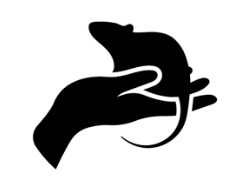The Social Rat #4: Ways in which rats are known to be social
In the previous article, I listed ways in which rats are known to be social – essentially social behaviours. Today we are going to look at some of these in more detail. I will also include links to research papers where these behaviours have been studied in the laboratory.
The positive versus negative false divide
As humans, we tend to look at things like emotion and behaviour as positive or negative. This is a false distinction. Every emotion or behaviour that is not self-destructive could reasonably be called positive, and those that are self-destructive called negative.
But as most animals are not self-destructive, even this division is not helpful when discussing the social rat. Emotion is just emotion. Its purpose is survival, therefore (for the individual at least) it is helpful. Behaviour is fine-tuned over millennia to maximise survival. So, it too is helpful – at least for the individual. Where animals have come together as a survival strategy – that is, those who are social – all species-wide emotions and behaviours are important. Aggression allows for a cohesive social group just as surely as nurturing, and exclusion can aid the group’s survival as much as co-operation.
So, let’s look in more detail at the social behaviours of rats and their purpose for the individual and the group. We have already covered aggression in the last article and will split the remaining social behaviours over two blog posts.
Playfulness
Most animal species demonstrate play behaviours, especially as juveniles, though some individuals maintain play through into adulthood. The full purpose of play is not fully understood or agreed upon, but notably, play behaviours can have similarities and differences across species. Some of the characteristics include:
activities from a variety of contexts are linked together sequentially
specific sets of signals (visual, vocal, chemical, tactile) including gestures, postures, facial expressions, gaits, odours, and sounds are important in the initiation of play
certain behaviors such as threat and submission, are absent or occur infrequently
there are breakdowns in dominance relationships, role reversals, changes in chase-flee relationships and contact time, and individuals engage in self handicapping
and there are detectable changes in individual motor acts and differences in sequencing when compared to non-play situations
Social Play Behaviour
Despite the purpose of play remaining elusive, there are clear advantages and risks associated with place, along with species-wide types of play behaviour. The following list of rattie gains is lifted from I want to play, one of the Ratwise behavioural series of PDFs.
Fitness
Robust proprioception
Robust stress responses
Increased sociability
Increased brain size and development
Increased trainability
Potential increase in lifespan.
The main risks of play are physical injury and even death.
Because of the role reversals, breakdown of dominance, and extra contact time that play provides, the behaviour can carry both social learning and social bonding benefits. Many rats enjoy play even as young adults, but eventually play behaviour diminishes in favour of more sedate (less risky) bonding activities, like grooming.
Helpfulness
Helpfulness is a general term meaning any behaviour of one individual towards another that benefits the other. Recent research involving rats has shown that to a large degree this type of behaviour is driven by olfactory messaging (odours).
But whatever the driver, rats will help other rats and this behaviour can overlap with co-operation, nurturing, altruism, and even empathy. Until I read this research showing the rat’s capacity to help regardless of reciprocity, I would not even have listed helpfulness as a rat behaviour, that was different from co-operation or empathy. The smell of cooperation: rats increase helpful behaviour when receiving odour cues of a conspecific performing a cooperative task
However, it turns out that a rat will help another rat (even when they haven’t been the recipient of help) on the back of smelling odour cues that indicate another rat is helping. The research team postulated that a rat might give out these odour cues in social situations to increase the likelihood that they, themselves will be helped.
Exclusion and self-exclusion
Exclusion is the practice of isolating individuals from the group. Self-exclusion occurs when an individual removes themself from the group. Both occur in nature and may be seen in domesticated rat groups. The most common practice of exclusion is that of removing reproductive competition.
This would often occur when a single male was maintaining a territory and a group of does. Exclusion would not only involve aggressively defending the territory from other adult males but would involve chasing off juvenile male offspring once they were sexually mature.
It is also seen in large colonies where low-ranking males can fail to thrive or reproduce in a competitive environment. These rats are often dispersed (through social pressure) away from the colony where they were born. The same rats can thrive and reproduce in different circumstances; however, a solitary evicted male would be more vulnerable to predation.
Remnants of exclusion behaviour are seen frequently in captive male rats where previously stable groupings are disrupted as juveniles mature into adults. A surge of male rat development occurs at some point between approximately 7 and 10 months, with accompanying androgen activity and broadening of the physical structure of the rat. This is a prime time for young males to challenge the group hierarchy and a difficult time for them to accept incoming young males into the group. Many problematic introductions are down to rats practicing some kind of exclusion behaviour.
Self-exclusion can happen when a rat is emotionally traumatised by bullying and social stress in captivity. In the wild, these rats would leave the group and set up a territory elsewhere, or perhaps find a place in a larger colony with a looser structure. In a caged setting, they cannot leave but will try to find a place of ‘safety’ that they can both hide away in and defend.
There is some anecdotal evidence to suggest that rats who are seriously ill or nearing the end of their life may also practice self-exclusion. This may be a socially protective behaviour that prevents the vulnerable rat from attracting predators towards the rest of the colony. But I have yet to find any reference to this happening in wild rat observational studies (which are scant!)
Altruism and co-operation
Altruism could be described as “taking one for the team”. Many animals – including rats – are known to give warning calls when faced with a predator, despite the vocalisation clearly exposing their own position. The rat who takes a scouting or look-out role within a colony is demonstrating altruism.
Another aspect of altruism is a willingness to help someone when there is no personal gain in doing so. The helpfulness study mentioned above clearly demonstrates a rat’s capacity to do this. The behaviour is largely driven by scent cues.
The purpose of altruism from an evolutionary perspective is probably two-fold. Firstly, it maintains the well-being of the group (which usually includes offspring – or more bluntly, the individual’s genetic material). Secondly, it increases the likelihood that the individual will be helped in return when help is needed.
Co-operation – or working together for the benefit of the whole – expresses in many ways in a rat colony. These include the acceptance of hierarchy and roles, nannying behaviours (where related females help to raise litters), urine trails that scouting rats make to lead other colony members to food, food stashing, nest building, and joint problem-solving.
Bullying behaviours
It is not uncommon in domesticated rats to see one rat bully another (usually males). This occurs when one rat uses their status or physical strength to intimidate another, often to the extent of preventing them from moving freely around the cage, enjoying the company of the other rats, or preventing them from eating.
While this may feel like mean behaviour to us, it’s a natural part of the wild male rat’s repertoire to oust low ranking males from the group. This increases his chance of fathering offspring and lowers the need for resources for the group as a whole. It can also be in the interests of the low-ranking rat, as they may go on to thrive as a lone rat with a group of females elsewhere. Of course, it is also a vulnerable position to be in, as they risk predation before they get established elsewhere.
In captivity, there is nowhere to escape to and we, as guardians, are responsible for making whatever changes are necessary to allow our rats to live in peaceful, cooperative groups.
Empathy
Empathy refers to the ability of one individual to feel and respond to the emotional distress of another. It has been widely demonstrated that laboratory rats will help out other rats in a variety of situations – for example, opening a door to free a trapped rat.
Clearly, the development of empathy helps a group to live co-operatively and handle threatening situations for the good of each individual – and, therefore, the whole. As with all behavioural traits, individual rats can display degrees of empathetic behaviour, from very little to large amounts.
Rat empathy has been shown to rely on positive social interactions. So, a rat who is kept in isolation usually won’t help out another rat in distress. Taking action: Empathy and social interaction in rats.
That brings today’s article to a close. Look out for coverage of more social behaviours, including nurturing, social bonding, inequity aversion, infanticide, and protectiveness in the next article (5) in The Social Rat series.
References:
Manon K Schweinfurth (2020) The social life of Norway rats (Rattus norvegicus) eLife 9:e54020 https://doi.org/10.7554/eLife.54020
Venniro, M., Golden, S.A. Taking action: empathy and social interaction in rats. Neuropsychopharmacol. 45, 1081–1082 (2020). https://doi.org/10.1038/s41386-019-0596-0
Gerber Nina, Schweinfurth Manon K. and Taborsky Michael (2020) The smell of cooperation: rats increase helpful behaviour when receiving odour cues of a conspecific performing a cooperative task Proc. R. Soc. B.2872020232720202327 http://doi.org/10.1098/rspb.2020.2327

